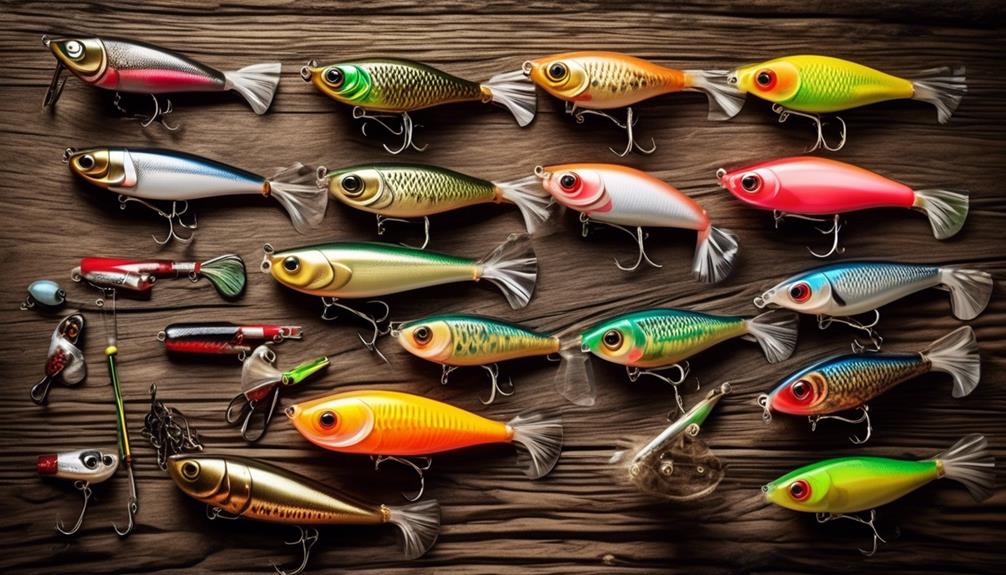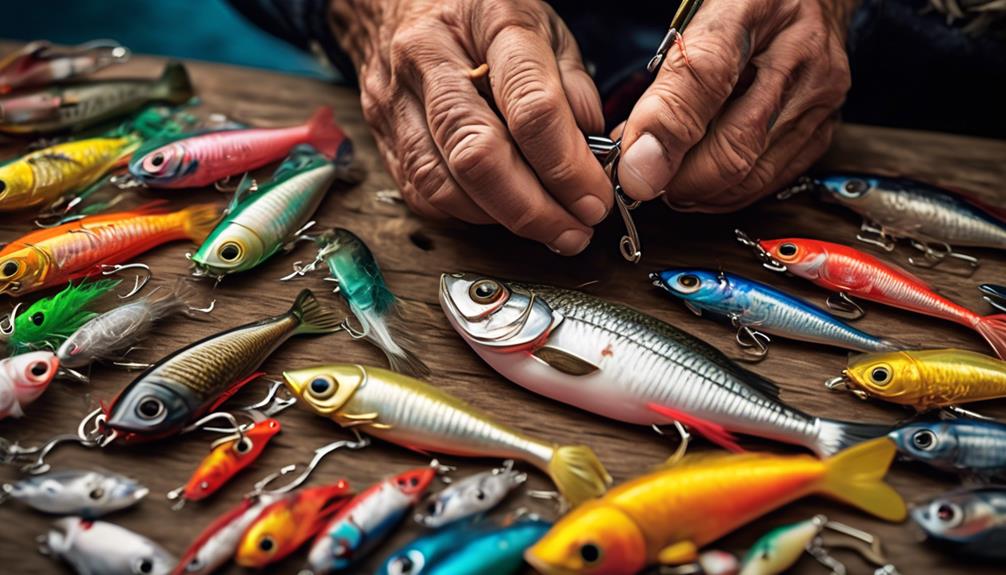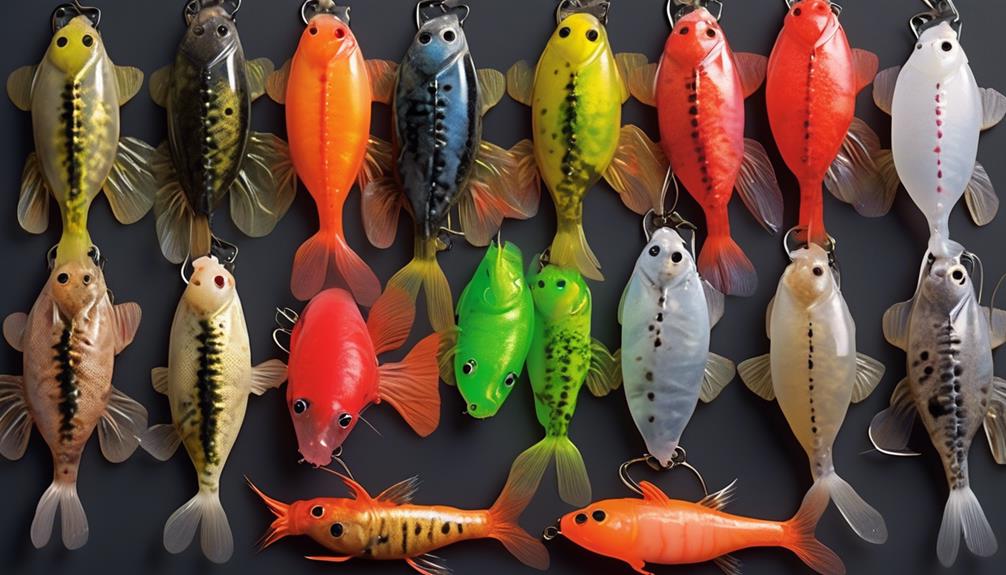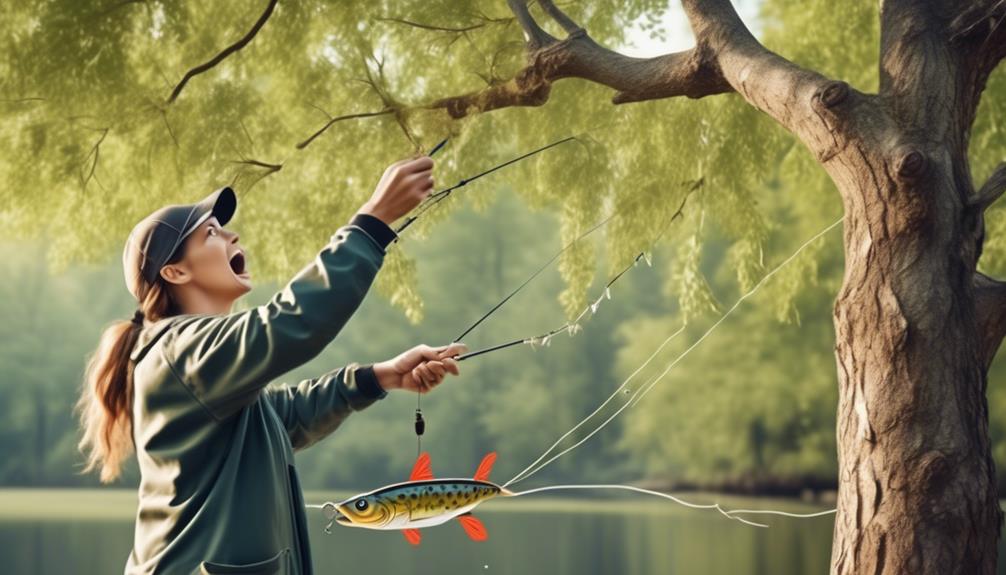You might think that all freshwater angling lures are basically the same, but when it comes to catching different species of fish, having a variety of lures in your tackle box can make all the difference.
From spinnerbaits to swimbaits, there are numerous types of lures designed to attract and entice fish in various ways. Understanding the different types of lures and when to use them can significantly improve your angling success.
But how do you know which lure to use in different situations and conditions?
Keep reading to discover the unique characteristics and benefits of each type of freshwater angling lure, and how they can help you reel in more fish on your next fishing trip.
Spinnerbaits
Looking for a versatile and effective lure for freshwater angling? Let's delve into the world of spinnerbaits and explore their unique advantages and applications.
Spinnerbaits techniques can vary widely, but one popular method involves casting the spinnerbait near cover, such as submerged logs or overhanging vegetation, and then retrieving it with an erratic, pulsating motion to mimic the movement of injured baitfish. This technique often entices predatory fish to strike.
Another effective approach is slow-rolling the spinnerbait along the bottom, particularly in deeper water or when fish are less active.
Spinnerbaits customization is a key aspect of their effectiveness. Anglers can modify spinnerbaits by changing the blade configuration, color patterns, and skirt materials to match the prevailing conditions and the behavior of the target species.
Additionally, adjusting the Spinnerbaits retrieve speed is crucial. Experimenting with different retrieval speeds can help determine the most effective presentation for enticing fish to strike. Varying the speed can trigger more aggressive strikes from active fish or entice sluggish fish in colder water temperatures.
When it comes to Spinnerbaits color selection, it's essential to consider water clarity and light conditions. In clearer water, natural or translucent colors such as shad or perch patterns tend to be more effective. In contrast, in murkier water or low light conditions, using brighter, more visible colors like chartreuse or white can enhance the lure's visibility and appeal to predatory fish.
Crankbaits
Spinnerbaits offer versatility and effectiveness, and now let's explore a different type of lure that's widely used for freshwater angling: crankbaits. Crankbaits are designed to imitate the swimming action of a baitfish, making them an excellent choice for targeting predatory fish like bass, pike, and walleye. Their design typically includes a lip or bill at the front, which causes the lure to dive and swim at specific depths when retrieved. This design allows anglers to cover a wide range of depths and structures, from shallow weedy areas to deep rocky drop-offs.
When it comes to crankbait retrieval techniques, there are several methods to consider. One popular technique is the steady retrieve, where you simply reel in the crankbait at a consistent speed, allowing it to dive to its designated depth and swim with a natural action. Another effective method is the stop-and-go retrieve, where you reel in the crankbait, then pause intermittently to mimic a wounded or disoriented baitfish. Varying the retrieval speed and adding twitches or jerks can also trigger strikes from fish that are following the lure.
Jigs
Jigs are versatile and effective lures widely used for freshwater angling, known for their ability to mimic natural prey and entice a variety of fish species. When it comes to jig fishing techniques, it's essential to understand that jigs are designed to be fished in a vertical manner, often with a jigging motion to imitate injured or fleeing baitfish. This motion can be achieved by lifting and dropping the rod tip, causing the jig to dart and fall enticingly.
Additionally, dragging or hopping the jig along the bottom can also yield great results, especially for bottom-dwelling species like bass and walleye. Experimenting with different retrieval speeds and motions is key to finding what works best on any given day.
Jig color selection is another crucial aspect of successful jig fishing. As a rule of thumb, darker jigs work well in stained or murky water, while natural, lighter-colored jigs are more effective in clear water conditions. However, it's important to remain adaptable and let the fish's response guide your choice. Sometimes, a bold, contrasting color may trigger more strikes, so don't be afraid to try something different if the standard colors aren't producing results.
Pay attention to the natural forage in the area you're fishing and choose jig colors that closely resemble the prevalent prey species.
Mastering jig fishing techniques and understanding jig color selection will undoubtedly improve your success when targeting freshwater species.
Soft Plastic Baits
Soft plastic baits offer a different approach to enticing fish compared to jigs, providing anglers with a versatile option for targeting freshwater species. These lures come in various shapes and sizes, mimicking natural prey and allowing for a range of presentation techniques.
When using soft plastic baits, consider the following:
- Weight Options: Soft plastic baits can be paired with different weights to achieve varying depths and rates of fall. Lighter weights are suitable for shallow water or a slow descent, while heavier weights are ideal for deeper areas or a faster drop. Experiment with different weights to find the most effective option for the conditions you're fishing in.
- Presentation Techniques: These baits can be presented in numerous ways, such as Texas rigging, Carolina rigging, or wacky rigging. Each technique offers a unique action and appearance, appealing to different fish species. Be sure to vary your presentation to determine what the fish are responding to on any given day.
- Color Selection: The color of soft plastic baits can significantly influence their effectiveness. Consider the water clarity and the prevalent forage species when selecting colors. In clear water, natural and translucent hues often work best, while in murky water, brighter and bolder colors can be more visible to fish.
- Rigging Methods: The way in which the soft plastic bait is rigged can greatly impact its action and appeal to fish. Experiment with different rigging methods, such as Texas rigging, Carolina rigging, or drop shotting, to find the most effective presentation for the conditions and the behavior of the fish.
Topwater Lures
When targeting freshwater fish, using topwater lures can add excitement to your angling experience while enticing fish to strike on the water's surface. These lures create a thrilling surface action that visibly attracts fish, making it a popular choice for bass fishing. Popper lures, in particular, are excellent for bass fishing as they create a splashing and popping motion that mimics the sound of prey on the water's surface, provoking aggressive strikes from bass.
In addition to bass fishing, topwater lures are also highly effective for pike angling. The explosive strikes of pike are a sight to behold, and using topwater lures can lead to heart-pounding encounters with these formidable predators. The erratic movement and commotion caused by popper lures can trigger pike into striking, providing an exhilarating angling experience.
When using topwater lures, it's essential to consider the time of day. Early morning and late afternoon are prime times for topwater action, as the low light conditions and calmer waters make it easier for fish to spot and strike at surface lures. Furthermore, topwater lures are best used in calm to mildly choppy waters, as excessive waves can impede their effectiveness.
Spoon Lures
Spoon lures, like topwater lures, offer an exciting and effective approach to freshwater angling, providing a versatile option for enticing a variety of fish species. Here are some key points to consider when using spoon lures:
- Reflective Appeal: Spoon lures have a reflective appeal due to their curved, metallic design. The light reflecting off the spoon's surface mimics the flash of baitfish, attracting the attention of predatory fish in the area.
- Versatile Design: These lures come in various sizes, colors, and finishes, allowing you to adapt your presentation to different fishing conditions and target species. Their versatility makes them suitable for both shallow and deep waters.
- Retrieval Techniques: Experiment with different retrieval techniques to find the optimal presentation for the specific fish species you're targeting. Varying the speed of your retrieve or adding intermittent pauses can make the spoon flutter and wobble, making it irresistible to fish.
- Optimal Presentation: When using spoon lures, it's important to focus on presenting them in a natural and enticing manner. Consider the behavior of the fish you're targeting and adjust your presentation to mimic the movements of their natural prey.
Jerkbaits
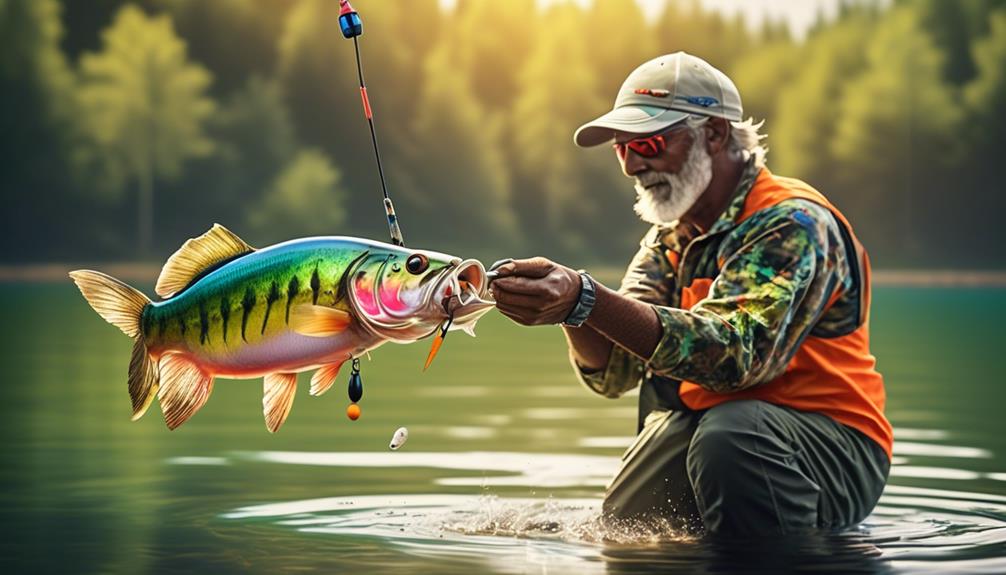
One effective lure for freshwater angling is the jerkbait, known for its erratic swimming action that mimics injured baitfish, enticing predatory fish to strike. Jerkbaits are particularly effective during the cooler months when fish are more sluggish.
When using jerkbaits, it's crucial to master the jerkbait techniques, such as the 'jerk and pause' method, where you jerk the rod to make the bait dart to the side and then pause, imitating the movement of a wounded fish. This technique can be especially effective during the fall and early spring when fish are actively feeding.
Seasonal effectiveness is key when using jerkbaits. During the colder months, slower retrieves with longer pauses often yield better results. As the water temperature rises, a more aggressive and faster retrieve can trigger strikes from active fish.
When selecting jerkbait colors, consider the water clarity. In clearer waters, natural and more translucent colors like silver, pearl, or perch can be more effective. In stained or murky waters, brighter and more vibrant colors like chartreuse, firetiger, or orange can be highly visible and draw more strikes.
Swimbaits
A natural progression from mastering jerkbait techniques is to explore the effectiveness of swimbaits for enticing freshwater game fish. Swimbaits are versatile lures that closely mimic the appearance and swimming action of prey fish, making them an excellent choice for targeting bass and other predatory freshwater species.
When using swimbaits for bass, consider the following:
- Swimbait Styles: There are various swimbait styles available, including soft plastic paddle tail swimbaits, hard body jointed swimbaits, and multi-jointed swimbaits. Each style has its unique swimming action and is effective in different fishing conditions.
- Choosing the Right Size: Selecting the appropriate swimbait size is crucial for enticing bass. Match the size of the swimbait to the prevalent forage in the water body. Larger swimbaits are ideal for targeting bigger bass, while smaller ones are suitable for catching smaller bass and in waters with smaller baitfish.
- Retrieve Techniques: Experiment with different retrieval speeds and cadences to find the most effective technique. Varying the speed and pauses in your retrieve can trigger more strikes from bass that are closely tracking the swimbait.
- Targeting Structure: Focus on casting swimbaits near underwater structures such as submerged logs, rock formations, and weed beds where bass are likely to lurk and ambush prey.
Frequently Asked Questions
What Are the Best Types of Freshwater Angling Lures for Catching Bass in Murky Water?
For catching bass in murky water, the best freshwater angling lures are those that have high visibility and create strong vibrations.
Jigging techniques with brightly colored lures work well in murky water. Additionally, worm fishing in deep water can also be effective.
These types of lures will attract bass by standing out in the low visibility and reaching the deeper areas where bass often hide in murky conditions.
Are There Any Specific Techniques for Using Spinnerbaits in Heavy Vegetation?
When fishing with spinnerbaits in heavy cover, it's crucial to use the right techniques.
For effective spinnerbait retrieval, try slow-rolling the lure just above the vegetation to entice strikes.
Choose weedless spinnerbaits to prevent snagging and focus on casting close to the edges of the cover.
Experiment with varying retrieval speeds and pauses to find what works best in heavy vegetation.
Keep at it, and you'll increase your chances of landing a catch in those challenging spots.
Can Crankbaits Be Effective for Catching Trout in Fast-Moving Rivers?
Yes, crankbaits can be effective for catching trout in fast-moving rivers.
The key is to adjust your presentation to match the conditions.
Consider using smaller crankbaits to mimic the size of natural prey in the river.
Vary your retrieval speed to find the right action that triggers strikes.
Also, targeting areas where the current breaks and forms eddies can increase your chances of hooking trout.
Don't overlook the effectiveness of crankbaits in trout fishing, even in fast currents.
What Are Some Tips for Choosing the Right Soft Plastic Baits for Targeting Different Species of Freshwater Fish?
When choosing soft plastic baits for different freshwater fish, consider the species you're targeting. Match the lure size, color, and action to the specific fish behavior.
Use finesse techniques for bass and walleye, and more aggressive techniques for pike and muskie. Opt for natural colors in clear water and brighter hues in murky conditions.
Vary the retrieval speed and presentation to entice strikes. Experiment with different soft plastic baits and fishing techniques to find what works best.
How Can I Effectively Use Topwater Lures in Shallow, Weedy Areas to Attract Larger Fish?
To effectively use topwater lures in shallow, weedy areas to attract larger fish, focus on spinnerbaits and heavy vegetation. Use specific techniques like varying your retrieve speed and incorporating pauses to mimic injured prey.
Experiment with different lure presentations, such as walking the dog or popping the lure to create commotion on the water's surface.
Conclusion
So, whether you're casting for bass, trout, or pike, there's a wide variety of freshwater angling lures to choose from.
From the lively action of spinnerbaits to the realistic movement of soft plastic baits, each lure offers its own unique advantages.
Experiment with different lures to find the ones that work best for you in different conditions and locations.
Happy fishing!
